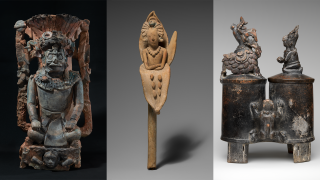
NBC 5 and the Kimbell Art Museum invite you to experience Lives of the Gods: Divinity in Maya Art, now through September 3 at the Kimbell Art Museum. This monumental and acclaimed exhibition brings together nearly 100 rarely seen masterpieces and recent discoveries in Maya art — one of the greatest artistic traditions of the ancient Americas.
Created by masters of the Classic period (A.D. 250–900) in the spectacular royal cities in the tropical forests of what is now Guatemala, Honduras and Mexico, these landmark works evoke a world in which the divine, human and natural realms are interrelated and intertwined. Presented across diverse media that depict episodes in the life cycle of the gods, the exhibition offers compelling reflections on representations of the divine and new understandings of Maya creative practices and the artist’s role in Maya society. Lenders include major museum collections in Europe, the United States and Latin America, with many works on view for the first time in the U.S., including new discoveries from Palenque (Mexico) and El Zotz (Guatemala).
Maya mythology is rich and complex — to date, its cast of divine protagonists, as represented through dense iconography, has not been the focus of an exhibition. For the ancient Maya, gods were born, lived as infants, reached their peak of maturity and influence, aged and ultimately perished, some to be born anew. This exhibition examines depictions of deities and unpacks the complex imagery that revealed such godly identities and divine aspects.
Maya artists gave form to the gods in remarkably imaginative ways, through works of astonishing visual complexity and aesthetic refinement. Exquisitely carved sculptures were believed to embody divine power and presence; skillfully carved ornaments of jadeite, shell and obsidian once adorned kings and queens, symbolically connecting them to supernatural forces; and finely painted ceramics reveal the eventful lives of the gods in rich detail.
Get DFW local news, weather forecasts and entertainment stories to your inbox. Sign up for NBC DFW newsletters.
Notably, Lives of the Gods brings to the forefront new discoveries and understandings of Maya culture. Recent advances in the study of Maya hieroglyphs have made it possible to identify the names of dozens of artists from the Classic period, and this marks the first time in a major exhibition that any of their names will be identified on the accompanying exhibition labels. While artist signatures are scarce on ancient art across the world, Maya sculptors and painters did sign their works, sometimes prominently, on beautifully carved stone monuments and delicately ornamented vessels. Lives of the Gods will include four works by named individuals, as well as several examples attributed to Maya painters.
Additionally, Lives of the Gods highlights recent achievements in the conservation and preservation of key artworks, including the impressive Throne 1 from Piedras Negras. Through a collaboration among conservators at The Metropolitan Museum of Art, the government of Guatemala and other scholars, the throne underwent a thorough technical examination to understand the residual pigments on the throne and determine the nature and origin of the stone from which it was carved. Conservation treatment stabilized structural issues of the fragmentary object, which had been deliberately destroyed in antiquity and reassembled after excavation in the 1930s. A new steel mount was created to support the throne during the exhibition as well as in earthquake-prone Guatemala to address the long-term preservation of the object. The reversible mounting technique used in the support structure provided an opportunity to correct the orientation of the throne’s legs, which recent epigraphic research had revealed were in reverse order.
The exhibition is organized thematically, following the arc of the lives of the gods and their place within a cosmological framework. The first section of the exhibition, “Creations,” will present mythical episodes related to the origin of the world. On August 11, 3114 B.C., before the advent of cities and writing in this part of the world, inscriptions tell us that the deities “were set in order,” and the gods placed stones in mythical locations. Maya kings replicated these divine actions at celebrations marking the ends of calendrical periods, each calculated at regular intervals from 3114 B.C. Featured here will be the Kimbell’s pair of elaborate censer stands (ca. 690–720, probably from Palenque), adorned with stacked masks that portray gods with both human and animal elements. During religious rituals, gods rested on these stands, which were thought of as their embodiments.
Local
The latest news from around North Texas.
“Day” will explore the balance between the gods of the day, such as the Sun God K’inich, and the nocturnal gods like the Jaguar God in the section “Night,” to follow. The sun was associated with life-giving forces, and rulers who identified closely with this power would often add the title K’inich to their name. Many deceased kings were portrayed as glorious new suns rising in the sky, overseeing their successors’ performance of royal duties. Equally imposing and dignified, Maya artists created imaginative and terrifying images of nocturnal deities. Jaguars — who figure prominently in imagery of the night gods — are powerful nighttime hunters in the Maya area, and therefore jaguar gods and goddesses all displayed an aggressive, warlike personality. There were also beautiful and often suggestive nocturnal deities such as the Moon Goddess, who was sometimes identified in texts as the sun’s wife or mother, represented in various narratives on vessels throughout this section.
The “Rain” section will feature depictions of two important and interrelated gods — the powerful rain god, Chahk, and the god of lightning, fertility and abundance, K’awiil. Rain gods were venerated throughout the Maya region, and acts of appeasement to them were, and still are, critical for the well-being of communities. A highlight will be a tripod plate (7th–8th century) that depicts Chahk waist-high in water, with the Maize God emerging from a waterlily in the depths below and celestial beings hovering above him.
The section on “Maize” chronicles this god’s life, death and rebirth through an assemblage of stunning and inventive masterpieces. The Maize God represented the beauty of the Maya staple crop and is often depicted by Maya artists as an eternally youthful, graceful being. The Maize God was also associated with two of the most valuable items in ancient Maya economies — jade and cacao. Episodes from the Maize God’s mythical saga appear on some of the ancient Americas’ finest ceramic vessels.
“Knowledge” will delve into the work of the scribes, who spent long years learning the intricacies of Maya writing and employed hundreds of signs in varied combinations, which can be seen throughout the exhibition — including on an exquisite vessel depicting two scenes of an old god instructing young pupils from the Kimbell. Only four of the books created in the pre-Hispanic period have endured to the present day, but texts that survive on relief sculptures and delicately painted ceramics provide a resource for understanding Classic Maya alliances, conquests and spiritual beliefs.
The final section, on “Patron Gods,” will include a striking series of works depicting kings and queens taking on various aspects and attributes of the gods. Maya artists created monumental sculptures to celebrate events and depict the perceived connection between rulers and the gods. Freestanding slabs known as stelae stood in the large plazas of Maya cities, and some of these sculptures bear the signatures of sculptors. Also on display will be a remarkable lintel — a horizontal support spanning a doorway — made of zapote wood. There are few Maya works carved in wood in antiquity that survive to the present day, and this lintel represents a celebration in the wake of the victory of Tikal (and its king Yihk’in Chan K’awiil) over rival Naranjo.
The extraordinarily rich array of exceptional sculptures, vessels and precious ornaments in the exhibition demonstrate the intimate relationship between Maya royalty and the gods, underscore the role of religion in the establishment and maintenance of Maya political authority and are a testament to the imaginative and technical virtuosity of Maya artists.
Lives of the Gods continues the Kimbell’s dedication to collecting and exhibiting objects that tell the stories of cultures from around the world. The exhibition follows the Kimbell’s history of important presentations of ancient American art, including The Blood of Kings: A New Interpretation of Maya Art (1986), Fiery Pool: The Maya and the Mythic Sea (2010–11), and Wari: Lords of the Ancient Andes (2013). Additionally, four objects from the museum’s permanent collection — a pair of impressive censers stands and two intricately painted vessels — are part of this landmark exhibition.
Lives of the Gods is a partnership between the Kimbell Art Museum and The Metropolitan Museum of Art. The Kimbell hosts this landmark exhibition during its 50th anniversary year of celebration.
For more information, visit www.kimbellart.org.
Lives of the Gods: Divinity in Maya Art
May 7, 2023 – September 3, 2023
Kimbell Art Museum
3333 Camp Bowie Boulevard
Fort Worth, Texas 76107
www.kimbellart.org



